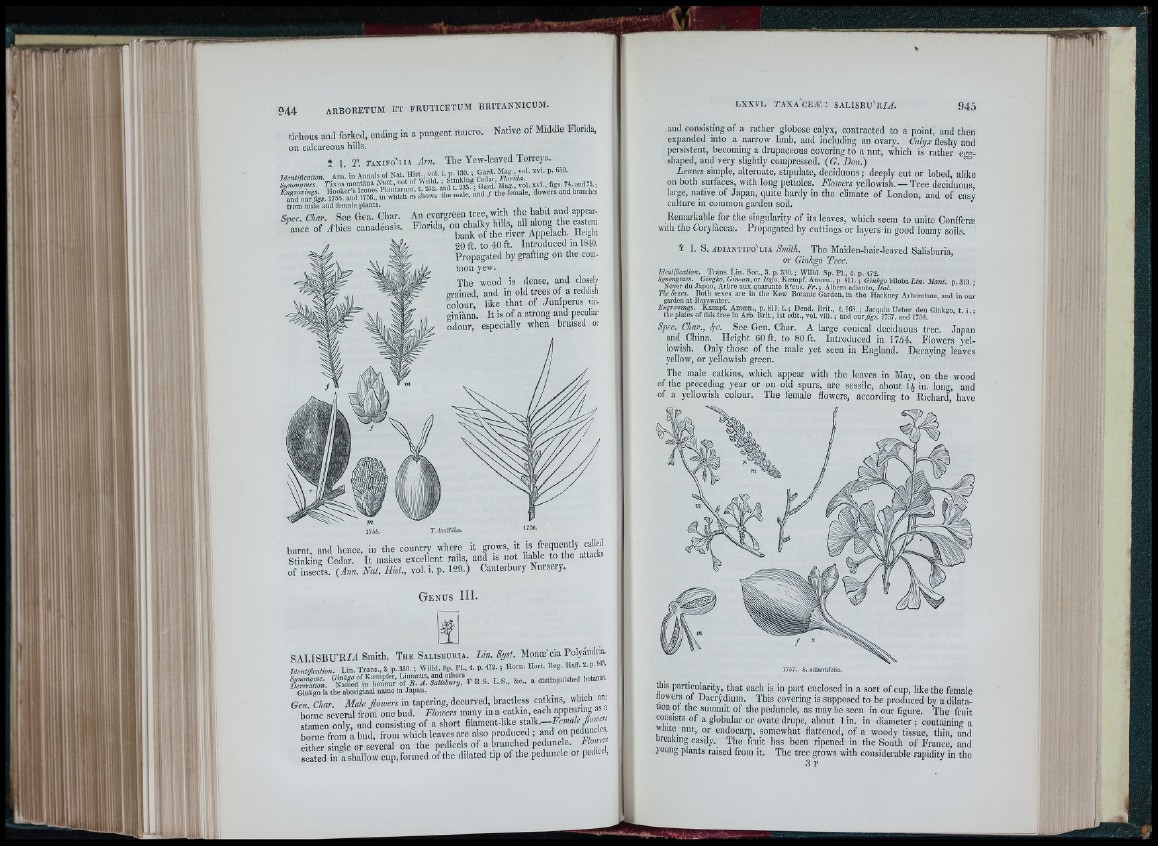
9 4 4 A R B O R E T U M E T F R U T IC E T U M B R IT A N N IC U M .
tirhous and forked, ending in a pungent mucro. Native of Middle Florida,
on calcareous hills.
t 1 T T A X i F o 'i iA Arn. The Yew-leaved Torreya.
Mrntification. Arn'. in Annals of N at Hista vol. i. p, 130 ; Gard M a g n o l . xvi. p. 639.
Synonymes. Táxus montàna Nrrti., not of vol. xvi., figs. 74. and75,-.
4 'n ? o ' i r * s . n S l V f l t a ' ! in w h X r i the male,' in d / the female, flowers and branches
from male and female plants. i
Svec Char See Gen. Char. An evergreen tree, with the habit and appear-
20 ft. to LO ft. Introduced in 1840.
Propagated by grafting on the common
yew.
The wood is dense, and closely
grained, and in old trees of a reddish
colour, like that of /uniperus virginiàna.
It is of a strong and peculiar
g odour, especially when bruised or
burnt, and hence, in the country where it grows, frequently caM
Stinking Cedar. It makes excellent rails and is not lufole to ffie attac
of insects. (Ann. Nat. Hist., vol. i. p. 129.) Canterbury Hiusery.
G e n u s III.
SALISBU'R/A Sniith. The Salisbubia. Lin. Syst. Monoe'cia Polyandria.
MentiJIcaUon. Lin. Trans., 3 p. 330. : Willd Sp P l., 4. p. 472. ; Horn. Hort. Beg. Half. 2. p.ML
.S .. f t c , a distinguished holanid.
G in k g o is the aboriginal name in Japan.
Gen. Char. Male flowers in tapering, decurved, bractless catkins, which ar^
borne several from one bud. F lowm many m a catkin, each appe. g <
stamen only, and consisting of a short filaraent-l.ke stalk.-rte««fe /» « »
borne from a bud, from which leaves are also produced ; and on peita"* ;
either single or several on the pedicels of a branched pedttnc e. /to»«
seated in a shallow cup,formed ofthe dilated tip of the peduncle oi peilicel,
L X X V I. TA X A C EÆ : s a l i s e u ' r / a . 9 4 5
and consisting of a rather globose calyx, contracted to a point, and then
expanded into a narrow limb, and including an ovary. Calyx fleshy and
persistent, becoming a drupaceous covering to a nut, which is rather eg»-
shaped, and very slightly compressed. (G. Don.)
Leaves simple, alternate, stipulate, deciduous ; deeply cut or lobed, alike
on both surfaces, with long petioles. Flowers yellowish. — Tree deciduous,
large, native of Japan, quite hardy in the climate of London, and of easy
culture in common garden soil.
Remarkable for the singularity of its leaves, which seem to unite Coniferæ
with the Corylàceoe. Propagated by cuttings or layers in good loamy soils.
Î 1. S. / ( d i a n t i f o ' l i a Smith. The Maiden-hair-leaved Salisburia,
or Ginkgo Tree.
Identification. Trans. Lin. Soc., Z. p. 330. ; Willd. Sp. P l., 4. p. 472.
Synonymes. Gir?gko,Gm-an, or lisjo, Kæmpf. Amcen., p 811. ; Ginkgo bMoha L in. Mant. d.313 •
Noyer du Japon, Arbre aux quarante E'cus, Fr. ; Albero adianto Ita l ' ’
The Sexes. Both sexes are in the Kew Botanic Garden, in th e Hackney Arboretum, and in our
garden at Bayswater. '
Engravings. Kæmpf. Amoen., p. 811. f. ; Dend. Brit., t. 168. : Jacquin Ueber den Gink?o t î •
the plates of this tree in Arb. B rit, 1st edit., vol. viii. ; and ourjîgs. 1757. and 1758.
Spec. Char., f r . See Gen. Char. A large conical deciduous tree. Japan
and China. Height 60 ft. to 80 ft. Introduced in ]7SL. Flowers yellowish.
Only those of the male yet seen in England. Decaying leaves
yellow, or yellowish green.
The male catkins, which appear with the leaves in May, on the wood
of the preceding year or on old spurs, are sessile, about IJ in. Ion», and
of a yellowish colour. The female flowers, according to Richard, have
1757. S. adiantifelia.
this particularity, that each is in part enclosed in a sort of cup, like the female
flowers of Dacrydium. This covering is supposed to be produced by a dilatation
ot the summit of the peduncle, as may he seen in our figure. The fruit
consists of a globular or ovate drupe, about I in. in diameter ; containing a
white nut, or endocarp, somewhat flattened, of a woody tissue, thin, and
breaking easily. The fruit has been ripened in the South of France, and
young plants raised from it. The tree grows with considerable rapidity in the
3 p